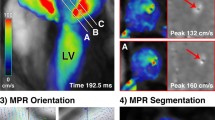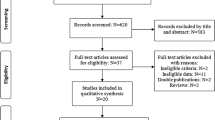Abstract
Object
Quantifying mitral regurgitation with cardiovascular magnetic resonance (CMR) involves indirect calculation, which increases the potential for error. We examined a direct quantification method using velocity mapping across the mitral valve, which may be less susceptible to error, and also examined the effect of heart rate variability on both techniques.
Materials and Methods
Fifty-five patients underwent mitral regurgitation quantification with CMR by the direct method and two indirect methods—the standard method subtracting aortic flow (assessed by velocity mapping) from left ventricular stroke volume (assessed by cine imaging) and the ‘volumetric’ method using the difference between left and right ventricular stroke volumes. The methods were compared using Bland–Altman analyses.
Results
Patients with low heart rate variability (beat-to-beat variability <30 bpm; n = 44) showed good agreement between direct and indirect methods (95% confidence limits for the difference between measurements ±16.7ml/11.8% regurgitant fraction for the standard method; ±21.7ml/15.4% for the volumetric method), with no significant offset (mean difference +2.8 ml/+1.9% for standard and +3.1ml/+2.3% for volumetric methods). Patients with high heart rate variability (>30 bpm; n = 11) showed poor agreement between techniques (95% limits ±80.3ml/56.0%) and significant offset (mean difference +31.7ml/+19.5%).
Conclusion
Direct quantification of mitral regurgitation with CMR compares well with indirect methods for patients with low heart rate variability, involves fewer calculations and is quick. All CMR measurements that use velocity mapping may be inaccurate, however, in patients with highly irregular rhythms and should be avoided in these patients.
Similar content being viewed by others
References
Singh JP, Evans JC, Levy D, Larson MG, Freed LA, Fuller DL, Lehman B, Benjamin EJ (1999) Prevalence and clinical determinants of mitral, tricuspid, and aortic regurgitation (the framingham heart study). Am J Cardiol 83: 897–902
Bonow RO, Carabello BA, Kanu C, de Leon AC, Jr., Faxon DP, Freed MD, Gaasch WH, Lytle BW, Nishimura RA, O’Gara PT, O’Rourke RA, Otto CM, Shah PM, Shanewise JS, Smith SC, Jr., Jacobs AK, Adams CD, Anderson JL, Antman EM, Faxon DP, Fuster V, Halperin JL, Hiratzka LF, Hunt SA, Lytle BW, Nishimura R, Page RL, Riegel B (2006) ACC/AHA 2006 guidelines for the management of patients with valvular heart disease: a report of the American College of Cardiology/American Heart Association Task Force on Practice Guidelines (writing committee to revise the 1998 Guidelines for the Management of Patients With Valvular Heart Disease): developed in collaboration with the Society of Cardiovascular Anesthesiologists: endorsed by the Society for Cardiovascular Angiography and Interventions and the Society of Thoracic Surgeons. Circulation 114:e84–231
Tribouilloy CM, Enriquez-Sarano M, Schaff HV, Orszulak TA, Bailey KR, Tajik AJ, Frye RL (1999) Impact of preoperative symptoms on survival after surgical correction of organic mitral regurgitation: rationale for optimizing surgical indications. Circulation 99: 400–405
Enriquez-Sarano M (2002) Timing of mitral valve surgery. Heart 87: 79–85
Zoghbi WA, Enriquez-Sarano M, Foster E, Grayburn PA, Kraft CD, Levine RA, Nihoyannopoulos P, Otto CM, Quinones MA, Rakowski H, Stewart WJ, Waggoner A, Weissman NJ (2003) Recommendations for evaluation of the severity of native valvular regurgitation with two-dimensional and doppler echocardiography. J Am Soc Echocardiogr 16: 777–802
Kon MW, Myerson SG, Moat NE, Pennell DJ (2004) Quantification of regurgitant fraction in mitral regurgitation by cardiovascular magnetic resonance: comparison of techniques. J Heart Valve Dis 13: 600–607
Enriquez-Sarano M, Miller FA Jr., Hayes SN, Bailey KR, Tajik AJ, Seward JB (1995) Effective mitral regurgitant orifice area: clinical use and pitfalls of the proximal isovelocity surface area method. J Am Coll Cardiol 25: 703–709
Enriquez-Sarano M, Avierinos JF, Messika-Zeitoun D, Detaint D, Capps M, Nkomo V, Scott C, Schaff HV, Tajik AJ (2005) Quantitative determinants of the outcome of asymptomatic mitral regurgitation. N Engl J Med 352: 875–883
Marsan NA, Westenberg JJ, Ypenburg C, Delgado V, van Bommel RJ, Roes SD, Nucifora G, van der Geest RJ, de Roos A, Reiber JC, Schalij MJ, Bax JJ (2009) Quantification of functional mitral regurgitation by real-time 3D echocardiography: comparison with 3D velocity-encoded cardiac magnetic resonance. JACC Cardiovasc Imaging 2: 1245–1252
Fujita N, Chazouilleres AF, Hartiala JJ, O’Sullivan M, Heidenreich P, Kaplan JD, Sakuma H, Foster E, Caputo GR, Higgins CB (1994) Quantification of mitral regurgitation by velocity-encoded cine nuclear magnetic resonance imaging. J Am Coll Cardiol 23: 951–958
Chatzimavroudis GP, Oshinski JN, Pettigrew RI, Walker PG, Franch RH, Yoganathan AP (1998) Quantification of mitral regurgitation with MR phase-velocity mapping using a control volume method. J Magn Reson Imaging 8: 577–582
Oshinski JN, Ku DN, Bohning DE, Pettigrew RI (1992) Effects of acceleration on the accuracy of MR phase velocity measurements. J Magn Reson Imaging 2: 665–670
Hamilton CA, Moran PR, Santago P, Rajala SA 2nd (1994) Effects of intravoxel velocity distributions on the accuracy of the phase-mapping method in phase-contrast MR angiography. J Magn Reson Imaging 4: 752–755
Nishimura DG, Jackson JI, Pauly JM (1991) On the nature and reduction of the displacement artifact in flow images. Magn Reson Med 22: 481–492
O’Brien KR, Myerson SG, Cowan BR, Young AA, Robson MD (2009) Phase contrast ultrashort TE: a more reliable technique for measurement of high-velocity turbulent stenotic jets. Magn Reson Med 62: 626–636
Lorenz CH, Walker ES, Morgan VL, Klein SS, Graham TP Jr. (1999) Normal human right and left ventricular mass, systolic function, and gender differences by cine magnetic resonance imaging. J Cardiovasc Magn Reson 1: 7–21
Sondergaard L, Lindvig K, Hildebrandt P, Thomsen C, Stahlberg F, Joen T, Henriksen O (1993) Quantification of aortic regurgitation by magnetic resonance velocity mapping. Am Heart J 125: 1081–1090
Kilner PJ, Gatehouse PD, Firmin DN (2007) Flow measurement by magnetic resonance: a unique asset worth optimising. J Cardiovasc Magn Reson 9: 723–728
Kozerke S, Schwitter J, Pedersen EM, Boesiger P (2001) Aortic and mitral regurgitation: quantification using moving slice velocity mapping. J Magn Reson Imaging 14: 106–112
Westenberg JJ, Doornbos J, Versteegh MI, Bax JJ, van der Geest RJ, de Roos A, Dion RA, Reiber JH (2005) Accurate quantitation of regurgitant volume with MRI in patients selected for mitral valve repair. Eur J Cardiothorac Surg 27:462–466 discussion 467
Hundley WG, Meshack BM, Willett DL, Sayad DE, Lange RA, Willard JE, Landau C, Hillis LD, Peshock RM (1996) Comparison of quantitation of left ventricular volume, ejection fraction, and cardiac output in patients with atrial fibrillation by cine magnetic resonance imaging versus invasive measurements. Am J Cardiol 78: 1119–1123
Author information
Authors and Affiliations
Corresponding author
Rights and permissions
About this article
Cite this article
Myerson, S.G., Francis, J.M. & Neubauer, S. Direct and indirect quantification of mitral regurgitation with cardiovascular magnetic resonance, and the effect of heart rate variability. Magn Reson Mater Phy 23, 243–249 (2010). https://doi.org/10.1007/s10334-010-0222-y
Received:
Revised:
Accepted:
Published:
Issue Date:
DOI: https://doi.org/10.1007/s10334-010-0222-y




